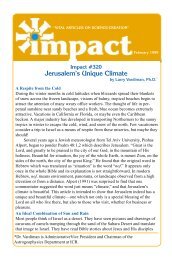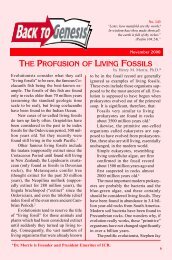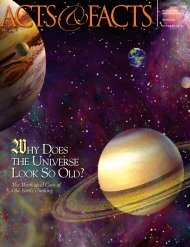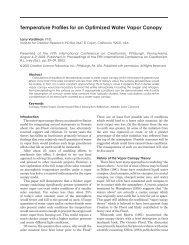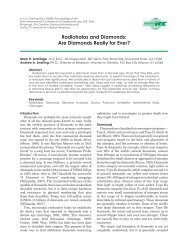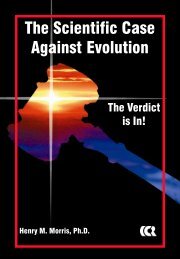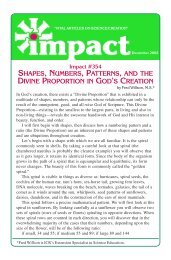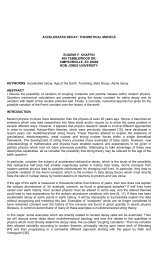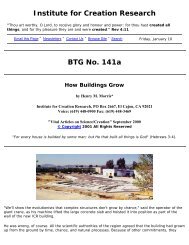Download September 2008 PDF - The Institute for Creation Research
Download September 2008 PDF - The Institute for Creation Research
Download September 2008 PDF - The Institute for Creation Research
Create successful ePaper yourself
Turn your PDF publications into a flip-book with our unique Google optimized e-Paper software.
IMPACTArber’s <strong>Research</strong> on EvolutionFor his study of mutations, Arber selectedbacteria because they have short generationtimes (20 minutes vs. 20 years <strong>for</strong> humans) andthere<strong>for</strong>e reproduce enormous numbers ofprogeny in only a few days. <strong>The</strong>y also do nothave sophisticated genetic repair mechanismsas do eukaryotes, allowing far more mutationsto be expressed in their offspring. One of Arber’sstudies evaluated 10,000 generations ofE. coli under various conditions, finding that“tremendous diversity accumulated withineach population.” 11 <strong>The</strong> phenotypic changewas very rapid <strong>for</strong> the initial 2,000 generations,but far slower <strong>for</strong> the subsequent 8,000generations, con<strong>for</strong>ming to the research onviruses that found the rate of fitness gain “deceleratedsignificantly over time,” as did the rateof nucleotide substitution. 11 Arber concludedthat genetic variety has definite limits, a findingcarefully documented by Behe. 7Most evolutionists believe that mutationsprovide the raw material <strong>for</strong> natural selection,and that these two mechanisms are thebasis <strong>for</strong> everything from the molecular machineryof the cell to the entire history of life onearth. Contrary to this belief, Behe found thatthe effect of these mechanisms on bacteria canexplain only marginal changes, and would account<strong>for</strong> very little of the basic machinery oflife and the variety of life existing today.In a review of the available researchfindings, Arber concluded that “bacteria usein parallel three qualitatively distinct naturalstrategies to obtain genetic variations.” 12 <strong>The</strong>sestrategies are 1) the acquisition of genetic in<strong>for</strong>mationoriginating from another organismby horizontal gene transfer, 2) recombinationrearrangements of DNA, and 3) small localchanges in the genome nucleotide sequence. 13Arber added that designed, genetically-encodedenzymes largely influence these rearrangements.<strong>The</strong>se enzymes function either as generatorsof genetic diversity, or as modulators ofthe frequency of genetic variation.This evidence indicates that the changeshe observed in bacteria resulted almost solelyfrom transposition and other types of chromosomalrearrangement, not mutations asrequired by macroevolution. 11 This study providesclear evidence that the putative evolutionobserved in microorganisms is primarily,if not totally, a result of built-in mechanismsdesigned to produce genetic, and thus phenotypic,variety.<strong>The</strong> steady implementation of these systems,together with non-genetic factors such as<strong>The</strong> claim that “more intensiveresearch is needed to understandthe apparent complexityof nature” is actuallyan admission of ignoranceabout the origin of complexityin the living natural world.external mutagens, cause genetic variation ofmicrobial populations and, by inference, geneticvariation in other populations. 12 We knowthis because similar genetic systems designedto produce genetic variety are also present inhigher organisms. <strong>The</strong>y likely have influencedthe past adaptations of these organisms andcontinue to play a role in causing minor geneticalterations.ConclusionsArber concluded that the genetic mechanismsthat produce variation are designedand are not products of Darwinian evolution.Furthermore, this variation—often calledmicroevolution—has clear limits and is unableto produce macroevolution. Arber stressedthat the knowledge of the “molecular basis ofbiological evolution” impacts not only “ourworldview” in the areas of origins, but also hasimplications <strong>for</strong> the possible risks of geneticengineering. 12 It is <strong>for</strong> this reason that Arber affirmedthat only the existence of a Creator Godis a satisfactory solution to the problem of biologicalorigins. 3References1. Speech by Peter Reichard, quoted in Arber, W, D. Nathans,and H. O. Smith. 1992. 1978 Physiology or Medicine. InJ. Lindsten (ed.), Nobel Lectures: Physiology or Medicine1971-1980. River Ridge, NJ: World Scientific Publishing,471-473.2. Schlessinger, B. and J. A. Schlessinger. 1986. <strong>The</strong> Who’s Whoof Nobel Prize Winners. Oryx Press: Phoenix, AZ.3. Arber, W. 1992. <strong>The</strong> Existence of a Creator Represents aSatisfactory Solution. In Margenau, H. and R. A. Varghese(eds.), Cosmos, Bios, <strong>The</strong>os: Scientists Reflect on Science,God, and the Origins of the Universe, Life, and Homo sapiens.La Salle, IL: Open Court, 141-143.4. Arber, W. 1979. Werner Arber: <strong>The</strong> Nobel Prize in Physiologyor Medicine 1978 Autobiography. In Odelberg, W.(ed.), <strong>The</strong> Nobel Prizes 1978. Stockholm: Nobel Foundation.Also available online at Nobelprize.org.5. Bullas, L. R., C. Colson, and A. Van Pel. 1976. DNA restrictionand modification systems in Salmonella. SQ, a newsystem derived by recombination between the SB system ofSalmonella typhimurium and the SP system of SalmonellaPotsdam. Journal of General Microbiology. 95 (1): 166-172.6. Blount, Z., C. Borland, and R. Lenski. <strong>2008</strong>. HistoricalContingency and the Evolution of a Key Innovation in anExperimental Population of Escherichia coli. Proceedings ofthe National Academy of Science. 105: 7899-7906.7. Behe, Michael. 2007. <strong>The</strong> Edge of Evolution. New York: <strong>The</strong>Free Press.8. Arber, W. 1996. Molecular Mechanisms Promoting andLimiting Genetic Variation. In Di Castri, F. and T. Younes(eds.), Biodiversity, Science and Development: Towards a NewPartnership. Walling<strong>for</strong>d, Oxon (UK): CAB International.9. Arber, W, D. Nathans, and H. O. Smith. 1992. 1978 Physiologyor Medicine, Nobel Lectures: Physiology or Medicine1971-1980, 469-492.10. Arber, W. 1991. Elements in Microbial Evolution. Journal ofMolecular Evolution. 33: 4-12.11. Papadopoulos, D. et al. 1999. Genomic Evolution During a10,000-Generation Experiment with Bacteria. Proceedingsof the National Academy of Science USA. 96: 3807-3812.12. Arber, W. 2001. Microbiology: Impact on <strong>Research</strong> in LifeSciences. Micron. 32: 5-6.13. Arber, W. 2000. GeneticVariation: MolecularMechanisms and Impacton Microbial Evolution.FEMS Microbiology Reviews.24: 1-7.Dr. Bergman is Professor ofBiology at Northwest StateCollege in Ohio.12 ACTS&FACTS • SEPTEMBER <strong>2008</strong>



